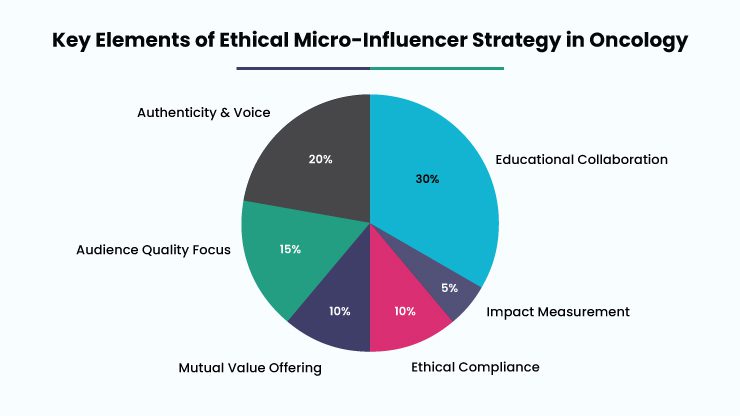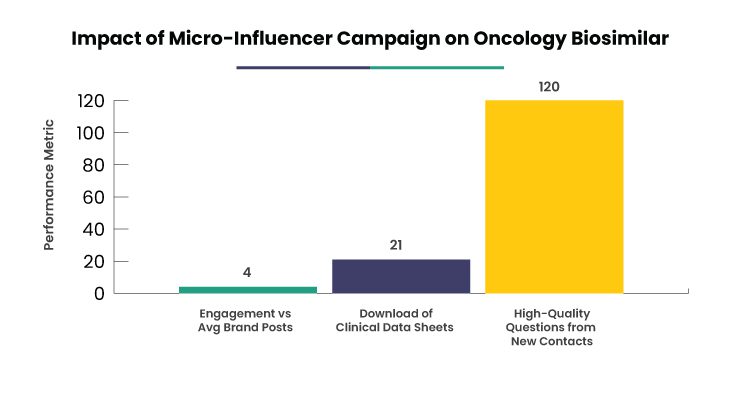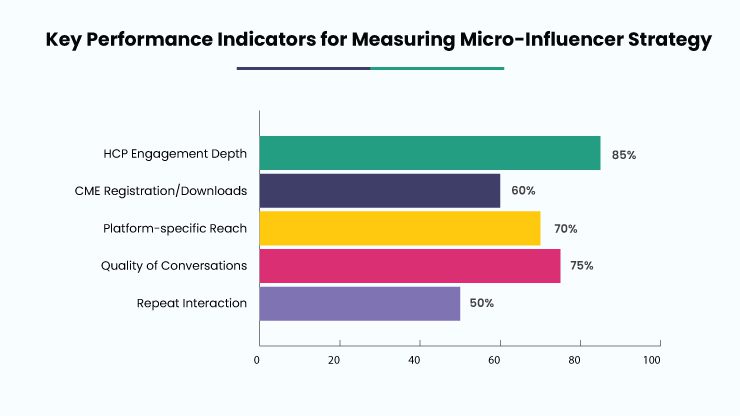Introduction: The Changing Face of Influence in Oncology
In the specialized field of oncology, influence has long been dominated by high-profile key opinion leaders (KOLs) – researchers, clinicians, and speakers at global conferences. These experts continue to shape the field, but a new generation of digitally active professionals is now making an impact in a different way.
These emerging voices, often referred to as micro-influencers, include early- to mid-career oncologists, researchers, and educators who engage peers through focused digital content. While they may not have massive online followings, their insights resonate with targeted professional audiences, leading to genuine influence within niche circles.
This article delves into how oncology marketers can engage micro-influencers ethically and effectively enhancing their brand presence while supporting education and peer learning in the oncology community.
Why Micro-Influencers Are Gaining Traction
- Focused expertise improves message alignment
Micro-influencers often specialize in narrow subfields such as gastrointestinal oncology, pediatric cancer care, or immunotherapy. Their content reflects real-world clinical insights, making it highly relevant to a specific set of professionals. This specialization ensures better alignment with your messaging goals.
- Peer relatability builds stronger connections
Unlike senior experts who may seem distant or institutionally bound, micro-influencers share content grounded in daily clinical experience. They often discuss practical decisions, diagnostic dilemmas, and case-based insights that resonate with peers. This fosters more authentic engagement.
- Digital fluency increases visibility and interaction
Most micro-influencers are active across professional social networks such as LinkedIn, X (formerly Twitter), and YouTube. Their use of short videos, infographics, and quick takes on clinical updates allows them to connect easily with a time-constrained audience.
- They promote dialogue, not just reach
The strength of micro-influencers lies in meaningful interaction. Their content sparks conversations among oncologists, fellows, and allied care providers creating a feedback loop of knowledge exchange that goes beyond superficial likes or shares.
How to Spot the Right Oncology Micro-Influencers
To identify suitable micro-influencers, follow this structured approach:
- Look for consistent, original contributions
Seek professionals who regularly post educational or opinion-based content on oncology topics. Avoid those who merely repost articles without context. Genuine micro-influencers share personal insights or translate new research into practical takeaways.
- Assess audience quality, not just quantity
An influencer’s value lies in who engages with them. Review their comment sections and post interactions. If known clinicians, residents, or CME organizers are responding, it signals high-impact engagement.
- Understand their institutional background
Affiliations with teaching hospitals or cancer centers enhance credibility. These professionals often participate in academic discussions and are well-connected to the continuing education ecosystem.
- Evaluate tone and professionalism
Professional tone matters, especially in regulated fields like oncology. Influencers who maintain a balanced, evidence-based voice are better suited for collaboration.
Ethical and Effective Ways to Work with Micro-Influencers
Start with collaborative education, not promotion
Rather than using influencers for direct advertising, involve them in developing educational material. This could include:
- Visual explainers of new trial results
- Case-based discussions shared on LinkedIn
- Expert commentary on evolving treatment guidelines
Keep the focus on peer education and scientific exchange.
Respect their voice and authenticity
Do not impose rigid scripts or brand-heavy messaging. Allow influencers to present topics in their own voice. Audiences engage because of the influencer’s authenticity – preserving this trust is crucial.
Offer mutual value
Beyond financial compensation, create professional development opportunities:
- Speaking slots at webinars or symposia
- Access to new clinical data or learning modules
- Featuring their work in branded medical content hubs
These benefits support career growth and build long-term relationships.
Match platform with content style
Each influencer has strengths on specific platforms:
- LinkedIn is ideal for academic discussions, carousels, and research highlights
- X (formerly Twitter) suits short clinical updates or event coverage
- YouTube or Instagram Reels can be used for explainer videos or digestible CME snippets
Choose formats that align with the influencer’s audience and communication style.

Example: Educating Physicians on Oncology Biosimilars
Background: A pharmaceutical company launching a trastuzumab biosimilar sought to educate oncologists in major Indian cities.
Execution:
- Identified six micro-influencers across academic hospitals
- Collaborated on visual posts correcting misconceptions about biosimilars
- Provided an unbranded portal link for more detailed resources
- Used analytics to track traffic and content downloads
Outcomes:
- 4 times more engagement than average brand posts
- 21 percent increase in downloads of clinical data sheets
- High-quality questions from over 120 new oncology contacts
The initiative showed that peer-led content, when designed for learning, delivers superior results compared to conventional ads.

Guidelines for Ethical Collaboration
- Be transparent: Always include clear disclosure of partnerships. Influencers should note that content is part of a sponsored collaboration.
- Avoid exaggerated claims: Ensure all shared information is accurate and medically approved. Avoid making comparisons or superiority statements.
- Stay within legal and ethical boundaries: Align campaigns with relevant marketing codes, including India’s UCPMP and data privacy regulations.
- Respect clinical neutrality: Influencers should not be pressured to endorse products or promote off-label use.
What to Measure in a Micro-Influencer Strategy
Track indicators that reflect meaningful professional engagement:
- Engagement depth: Clicks, comments, and shares from verified HCPs
- Conversion actions: CME registrations, downloads, or sign-ups
- Platform-specific reach: Unique visitors from LinkedIn or X posts
- Quality of conversations: Nature of responses and follow-up discussions
- Repeat interaction: Whether viewers revisit shared portals or engage in future campaigns
Avoid vanity metrics like total impressions. Focus on indicators tied to clinical interest and action.

Conclusion: Building Influence Through Trust and Value
Micro-influencers represent an evolving opportunity for oncology marketers. These professionals are educators at heart, and their digital content has the potential to inspire, inform, and influence within peer groups. When engaged respectfully and ethically, they can be powerful allies in delivering credible, relevant messages to HCPs.
Success in oncology marketing today is not about reaching everyone – it is about connecting meaningfully with the right people. Micro-influencers help you do exactly that, by acting as trusted bridges between your content and the professionals who rely on it for better patient care.
The Oncodoc team is a group of passionate healthcare and marketing professionals dedicated to delivering accurate, engaging, and impactful content. With expertise across medical research, digital strategy, and clinical communication, the team focuses on empowering healthcare professionals and patients alike. Through evidence-based insights and innovative storytelling, Hidoc aims to bridge the gap between medicine and digital engagement, promoting wellness and informed decision-making.



